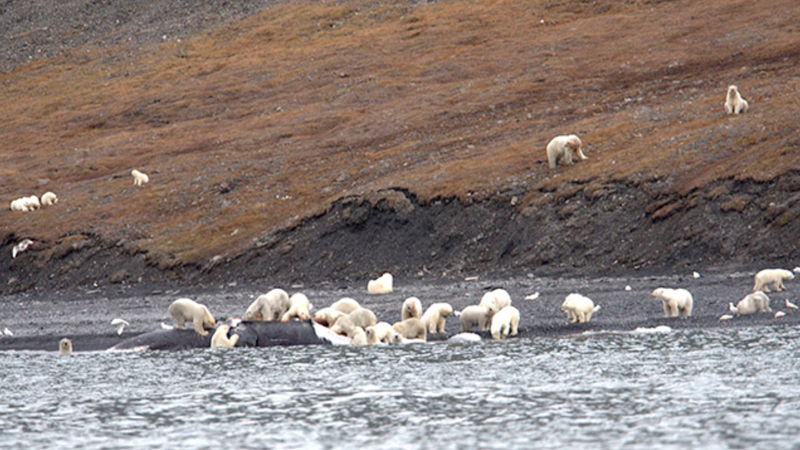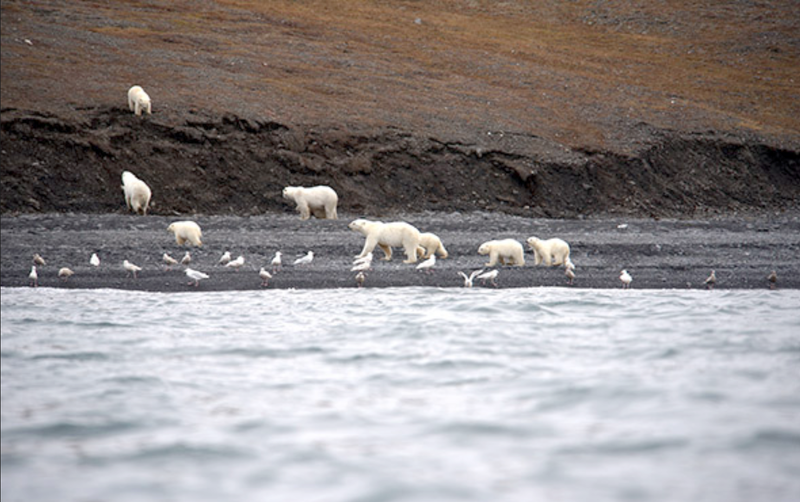John Dunbar: I'm here at my own request.
Major Fambrough: Really? Why?
John Dunbar: I've always wanted to see the frontier.
Major Fambrough: See the frontier--
John Dunbar: Yes, sir. Before it's gone.
For those magnificent moments, untouched by the septic hand of man, that only nature & science can create.
--------------------------------------------------------------------------------------------
Massive gathering of well over a hundred polar bears to feast on a whale carcass:

https://gizmodo.com/there-are-no-words- ... 1818991789
On September 19, a bowhead whale carcass washed ashore the remote Wrangel Island State Nature Reserve off the Northern coast of Siberia. Nearly 1 percent of the world’s polar bears amassed beside it for a Siberian feast.
“You had to live it to believe it, even now there are people pinching themselves to make sure it really happened,” Rodney Russ, Expedition Leader, Owner and Founder of Heritage Expeditions writes in his blog.
Russ counted at least 150 polar bears in the group, while a Wrangel Island news release cites 230 as the most conservative estimate.
I’ve reached out to the scientists at Wrangel Island for more information about the gathering. But for the tourists on the boat, it was an experience of a lifetime.
“We launched the zodiacs,” writes Russ, referring to a brand name of inflatable rafts, “for a closer look and that is the memory we will all carry with us. There are no words to describe it.”

Neat!
https://gizmodo.com/stunned-scientists- ... 1820054009
It’s tempting to think that all the great archaeological discoveries from ancient Egypt have already been made, but new research published today in Nature shows there’s still plenty for us to uncover.
An investigation into the internal structure of Khufu’s pyramid—the largest pyramid in Giza—has revealed the presence of a large and inaccessible “void” within the structure. The researchers who led the study, Mehdi Tayoubi from the HIP Institute in France and Kunihiro Morishima from Nagoya University in Japan, won’t go so far as to say the cavity is a hidden chamber, but they’re reasonably convinced the internal feature is a deliberate architectural feature of the pyramid. As to what’s inside is anyone’s guess, but the presence of artifacts and funeral items are not out of the question, according to Egyptologists.
The discovery was made possible through the unlikely intersection of archaeology and particle physics. By making meticulous measurements of muons—elementary particles that rain down on Earth from deep space and are capable of traveling through solid objects—researchers were able to characterize the densities within the pyramid, revealing the presence of an empty space that measures at least 100 feet (30 meters) in length.
But we all know what's in there and what's going to happen. Hopefully.


Cool!
What do you mean... inaccessible?
Can't we just teleport into those chambers? ![]()
Can't we just teleport into those chambers?
Soon. We should be able to do that sometime soon.
![Drink up [B-o]](./images/smilies/drinkup.gif)
As cool as the potential for a heretofore I seen chamber is, the thing that makes me equally happy is there’s at least some part of the pyramids that haven’t been scourged by artifact thieves. If we ever get to this chamber, we could find some truly unique artifacts that hopefully make their way into museums and not some rich bastards private collection.
Some are saying its just an empty space built in to reduce ceiling weight on the "Great Hall" below it.
But then again it could house Jimmy Hoffas' body.
It's a bathroom.
Exploratory deep-ocean research makes an incredible find - wreck of the USS Lexington (CV-2) found two miles down five hundred miles off the east coast of Australia:
http://www.foxnews.com/science/2018/03/ ... nking.html
The fleet aircraft carrier, the first to be sunk by opposing carrier aircraft in World War II, was found near Australia below Coral Sea in a remarkably well-preserved condition, news.com.au reported.
The expedition crew of Allen’s personal research ship R/V Petrel found the missing Lexington two miles below and about 500 miles off the eastern coast of Australia, according to USNI News.
“To pay tribute to the USS Lexington and the brave men that served on her is an honor,” Paul Allen said on his website. “As Americans, all of us owe a debt of gratitude to everyone who served and who continue to serve our country for their courage, persistence and sacrifice.”
As the Lexington was struck by multiple Japanese torpedoes and bombs on May 8, 1942, more than 200 Lexington sailors were killed in the fight, and nearby U.S. ships rescued 2,770 of the carrier’s remaining sailors, according to the Navy Times.
Great to see a wealthy person use his resources for the benefit of human posterity instead of just his own wants. And thankfully the great Grey Lady is down so deep that the wreck should remain safe from the sort of souvenir-hunters and metal-plunderers that have absconded with the steel from the many wrecks in Indonesian and Philippine waters.

Yeah his foundation has helped find a few notable wrecks of late. They found the USS Indianapolis last year and a few years ago, the Musashi.

If you hold your breath and plunge your face into a tub of water, your body automatically triggers what's called the diving response. Your heart rate slows, your blood vessels constrict, and your spleen contracts, all reactions that help you save energy when you're low on oxygen.
Most people can hold their breath underwater for a few seconds, some for a few minutes. But a group of people called the Bajau takes free diving to the extreme, staying underwater for as long as 13 minutes at depths of around 200 feet. These nomadic people live in waters winding through the Philippines, Malaysia, and Indonesia, where they dive to hunt for fish or search for natural elements that can be used in crafts.
Now, a study in the journal Cell offers the first clues that a DNA mutation for larger spleens gives the Bajau a genetic advantage for life in the deep.
https://news.nationalgeographic.com/201 ... n-science/
Answers to the questions that keep you up at night:
How (and why) wood frogs hold in pee all winter
I always assumed they didn't pee because they were little ice cubes. Guess not!
Canada’s Grand Cannabis Experiment Has Set Scientists Free
VANCOUVER, British Columbia — When Canada fully legalized recreational cannabis on Oct. 17, the internet giddily reimagined the CN Tower in Toronto peeking out from a thick haze and swapped the flag’s red maple leaf for its jagged-edged green cousin. Outsiders might titter about an entire populace turning into potheads, but legalization means some of the country’s brightest can now turn their minds to pot.
As the first G-7 nation to slacken cannabis laws, Canada has bolted to the front lines of the plant’s methodical scrutiny and investigation. No longer at risk of censure or lacking access to specimens, researchers can transcend the narrow parameters of scientific study once considered acceptable, namely, clinical research, to explore social, biological, genetic and agricultural questions. From botanists to phytochemists, microbiologists to epidemiologists, scientists of all sorts are free to openly pursue a greater quantity and quality of cannabis science than ever before.
Ninety-five years of prohibition has made for a rather brief encyclopedia entry, meaning what we do know mainly comes from anecdotal observation and short-term studies. But Canadian laboratories aren’t starting from scratch. It was Canada, in 2001, that became the first country to sanction the medical use of marijuana. It was a Canadian team, in 2011, that published the first sequence of the cannabis genome. Yet these landmark contributions, and the array of peer-reviewed studies that were spurred, rarely strayed past lines of inquiry that ran parallel with social norms.
Research lurched forward with the early legal steps, offering sick and suffering Canadians a new option to manage chronic pain, treat symptoms of PTSD and boost their overall quality of life. It dwindled under Prime Minister Stephen Harper, a Conservative who slashed health and drug policy budgets and slammed cannabis as “infinitely worse” than tobacco (experts say it’s the other way around). Research multiplied again in 2014, when commercial growers got clearance to supply mail-order medical marijuana to Canadian patients, commodification that simultaneously energized corporate interests.
Canada’s brand-new legislation, the Cannabis Act, replaces a restrictive system that treated researchers like would-be drug dealers. Scientists intending to cultivate their own plants can now simply apply for a specific class of license rather than toil for an exemption from the retrograde Controlled Drugs and Substances Act, which, among other demands, required criminal record checks.
The Canadian government, once unwilling to touch the stuff, has stepped up to properly examine how cannabis affects the body and brain. It’s funding 14 new studies and has set aside millions more for research grants that could ask questions like, Will a pregnant mother using cannabis harm her baby’s development? Does smoking affect drivers’ reaction time behind the wheel? And at what threshold does teenagers’ pot consumption become destructive?
https://www.nytimes.com/2018/11/20/opin ... anada.html
Can't we just teleport into those chambers?
If you want to be trapped in the Mummy's chamber with a 4,000 year old angry reanimated mummy, be my guest. I'll pass.